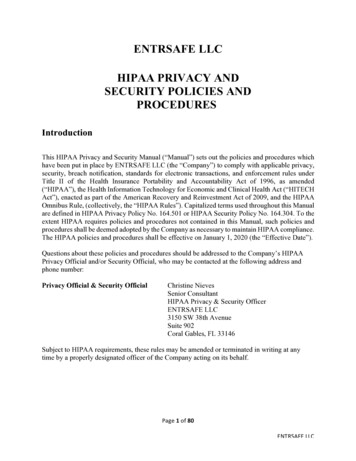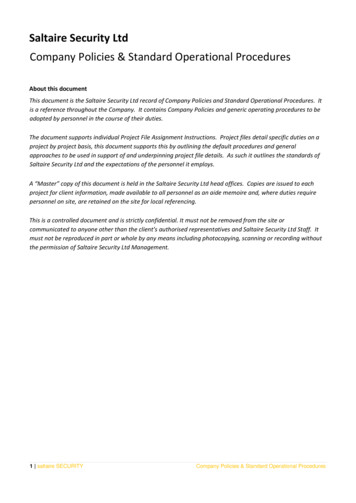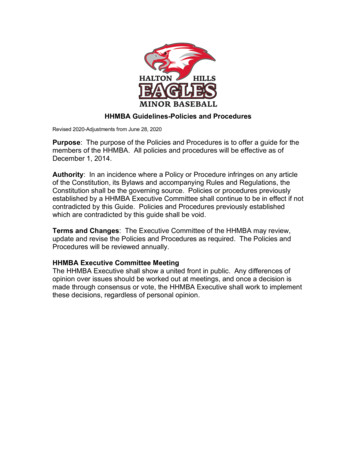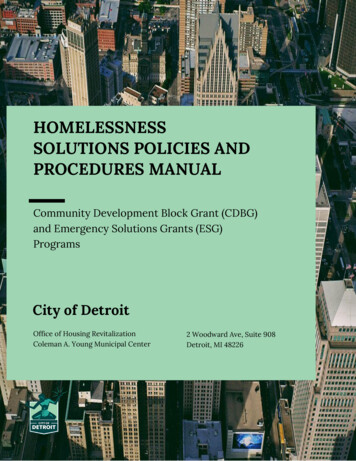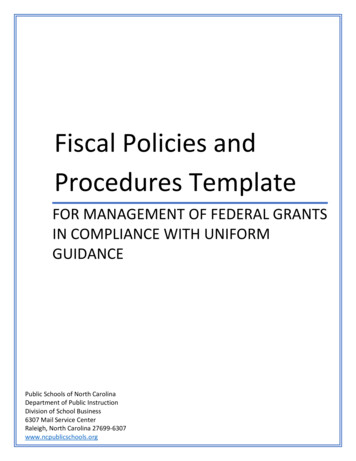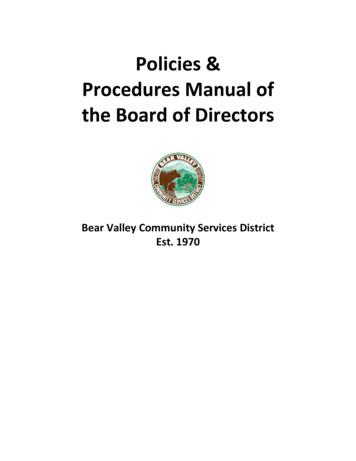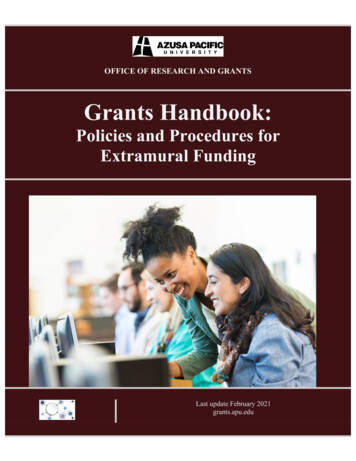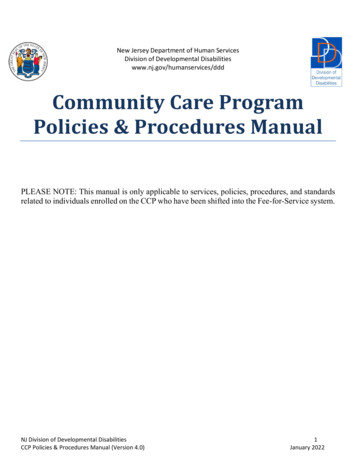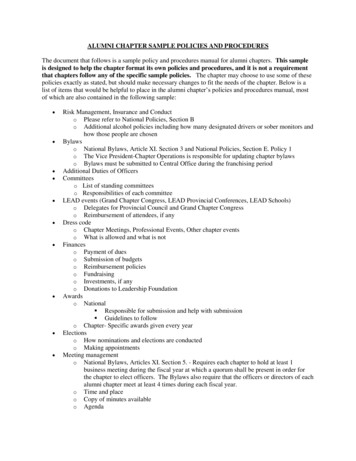
Transcription
CARE & SUPPORT POLICIES, PROCEDURES & GUIDELINESCS39 – HOARDING1.INTRODUCTION1Purpose1.1The Hoarding Procedure sets out the approach that Community Options staff will takewhen dealing with hoarding.1.2It applies to all clients living in homes supported by Community Options.1.3The procedure aims to balance the rights of the tenant, with Community Options duty to dealwith issues that can cause a health and safety issue.2Definition2.1Hoarding has been classified as a mental disorder and is a specific type of behaviourcharacterised by:Acquiring and failing to throw out a large number of items that would appear to havelittle or no value to others (e.g. papers, notes, flyers, newspapers, clothes).Severe cluttering of the person's home so that it is no longer able to function as a viableliving space.Significant distress or impairment of work or social life.2.2People who hoard may keep things for the same reasons as anyone else, includingsentimental value or utility value (item is / could be useful). The hoarder may view theirbehaviour as a lifestyle choice, and to some extent this is the case.2.3However, it is when it negatively impacts on the hoarder’s life or on others that it becomes anissue which requires action to be taken. For example, when:It is associated with self neglect or safeguarding concernsIt is contributing to a pest control issueIt has health and safety implicationsThe organisation is being hindered from carrying out a statutory duty (e.g. annual gassafety check)Page 1 of 8Policy/Procedure No: CS11Current Review Date: April 2016Next Review Date: April 2018Reviewer: Director of Operations Manager
3Implementation3.1Throughout the implementation of this procedure, staff must remain objective and shouldavoid making judgements on the tenant’s living conditions. Instead, the focus should be onthe property as an asset, whether the room(s) can be used for the intended purpose andwhether there are health and safety implications.3.2Each case will be different in terms of the type and extent of items hoarded, the risk, and thereasons behind the hoarding. We therefore use a combination of intervention measures,including support to tackle the hoarding. In doing this, we will take a multi agency approach,where appropriate.4ResponsibilitiesAll Staff4.1All staff are responsible for identifying clients where hoarding may be occurring andreporting this to the relevant Housing Management Officer and Resident ServicesManager in the Local Services Team.Contract Managers (and equivalents)4.2Contract Managers (and equivalents) are responsible for forwarding concerns that arereported by grantees or contractors or other agents to the relevant Housing Officer in theLocal Services Team. Grantees, contractors or other agents are responsible for makingCommunity Options staff aware of any concerns in relation to hoarding.Managers and Housing Management Officers4.3Managers and Housing Management Officers are responsible for acting as the centralcontact point that responds to concerns of hoarding. They are responsible for keepingthese cases under review and liaising with other relevant agencies5Identifying Hoarding5.1Any member of staff who has concerns that a tenant may be hoarding must report this totheir line Manager the Manager in turn should report concerns to the Housing Managementoffice and Contracts Manager where appropriate.5.2Other situations where hoarding behaviour may be identified include:Complaints or concerns registered by neighbour (pests, smells, unusual behaviour)Information from a statutory agencyWhere a concern about a garden raises a concern about the condition of the propertyPage 2 of 8Policy/Procedure No: CS11Current Review Date: April 2016Next Review Date: April 2018Reviewer: Director of Operations Manager
Home Visit and Hoarding Checklist5.3The Housing Management Officer (or an alternative staff member if the tenant is morewilling to engage with them) should visit the property and use the Hoarding Checklist(HOARD01) to identify whether the condition of the property meets the threshold forhoarding.5.4Housing Management Officers must use The OCD Foundation’s Clutter Image Rating scale(HOARD02) to record the level of hoarding and should consider whether the room can beused for its purpose, e.g. can the kitchen be used for cooking, or can the bathroom be usedfor washing or to go to the toilet?5.5Housing Management Officers should also consider whether there are any health andsafety concerns, e.g. storage of gas bottles, or storing items that could attract pests andvermin.5.6Photographic evidence is very important in all hoarding cases and the tenant should bemade aware of the requirement to take photographs. Client consent to take photographsshould be obtained using Part 3A of the Hoarding Checklist (HOARD01). If the tenantrefuses consent, the Housing Management Officer should use the OCD Clutter ImageRating scale to record the level of hoarding at each home visit.5.7 If the property condition meets the threshold for hoarding, the Housing Management Officershould agree the most appropriate course of action with the Service r. This could include(but is not limited to):Referrals to external agenciesVisits to the tenantDeveloping action plansEnforcement actionEngaging with friends, family or colleagues who have a good relationship with the tenant(But taking data protection considerations into account)Multi agency meetings5.8The role of the Service Manager and Housing Management officer is also to consider anyvulnerability or safeguarding issues.5.9It should be noted that the risk posed by the behaviour of the client may change during thelife of the case. Each case should be monitored by the Manager and Housing ManagementOfficer and the checklist should be completed again if any staff member becomes aware offactors that significantly alter the risk.Page 3 of 8Policy/Procedure No: CS11Current Review Date: April 2016Next Review Date: April 2018Reviewer: Director of Operations Manager
5.10 Contact with the client (either in person or by letter) should warn the client that failure toallow access and comply with other terms of their tenancy agreement is a breach of tenancyand could result in enforcement action being taken.6Action Plans6.1Action plans should be realistic, proportionate and tailored to the individual client, taking intoaccount the following factors:The tenant’s capacity and ability to carry out workThe severity of the condition of the client’s propertyThe risk of serious harm or accident as a result of the condition of the propertyResources of support agencies involved with the client6.2Wherever possible, action plans should be agreed with the client.6.3Actions should normally be agreed in stage and should include the support available fromCommunity Options staff.6.4The action plan should be confirmed in writing to the client.6.5Monitoring and regular visits should take place to review the progress of the action plan.6.6If at any point, access is not gained or the tenant stops engaging this should be referredimmediately to the Landlord.7Failure to gain access to the property7.1Where Housing Officers visit the property and are unable to access the property, they mustrecord each attempt at contact made. If the tenant does not answer the door, a ‘MissedVisit’ card should be left.7.2The Housing Management Officer should write to the tenant to make them aware that theyhave attempted to visit them, with an appointment time for a repeat visit and asking thetenant to contact the Housing Management Officer if the appointment time is notconvenient.7.3Housing Management Officers should be flexible in working around the commitments of thetenant. In cases where the tenant has attempted to delay access for more than 2 weeks, theHousing Officer should insist on arranging an appointment with the tenant to ensure access isgained.7.4If at the pre-arranged visit the client again refuses entry or is not present at the propertythen a second appointment letter should be sent stipulating the date and time of the visit.This appointment should be made to attend within one week.Page 4 of 8Policy/Procedure No: CS11Current Review Date: April 2016Next Review Date: April 2018Reviewer: Director of Operations Manager
7.5In some circumstances where the client repeatedly refuses access to the property, then itmay be necessary to consider contacting the Landlord regarding enforcement action to gainaccess (where there is a high risk issue, enforcement action may be considered earlier).8Support and referral to external agencies8.1Where family or friends are already involved, and willing to co-operate, we encourage theirassistance, however in doing this we will always comply with data protection principles. Ourpriority is to engage with the client personally, wherever possible.8.2Where the client is already engaging with a support service, we will try to work alongsidethis existing arrangement. This is important where the hoarder already has an establishedrelationship, as hoarders can at times be mistrustful of new services.8.3Where a referral has been made to other organisations, it is essential that these are followedup to ensure that the case is progressed.Fire Safety Referrals8.4Where it is believed that a tenant could be vulnerable to fire, the Housing ManagementOfficer must make an urgent Home Fire Safety Check Referral to the Health & SafetyManager. Referrals should be sent to: healthandsafety@Communtiy Options-housing.co.ukwithin 24 hours of the first home visit.8.5The Health & Safety Contract Manager in Property Services must also be informed of anyhigh risk fire cases so that they can be flagged on the Fire Risk Assessment database.Safeguarding Referrals8.6Where there is a concern about the tenant in relation to safeguarding, this should bediscussed with one of person’s care team and where necessary, a safeguarding alertraised in accordance with the Safeguarding Policy & Procedure.Environmental Health and other referrals8.7In some circumstances, hoarding cases should be discussed with the local EnvironmentalHealth Team to determine whether it is a statutory nuisance.9Clearance9.1Where the client is willing to engage, it may be possible to help them to plan and managetheir own clearance, or engage with an organisation who can assist them.It may be helpful to set small goals to be accomplished stage by stage. These should beprioritised. For example, clearing a room that houses a boiler with an outstanding safetycheck, or re-establishing cooking and washing facilities.9.2Page 5 of 8Policy/Procedure No: CS11Current Review Date: April 2016Next Review Date: April 2018Reviewer: Director of Operations Manager
9.3Where the client is engaging in the clearance, Housing Officers should assign them timeframed tasks and get them to consider the relevance of the item to its current setting, and toeither assign it an alternative suitable storage place or choose to discard it. This methodresults in items only being stored in appropriately assigned rooms (for sleeping, eating,cleaning, etc).9.4However, it should be recognised that due to the complexities of hoarding, removal of theitems without support being in place for the client will not necessarily resolve the situation inthe longer term as they may begin hoarding again and an enforced large scale clean up couldcause extreme anxiety to the tenant.9.5Each case will be dealt with on an individual basis. Where there is a serious risk, we will alwaystake action in relation to a clearance (preferably with the agreement of the cliennt, but wherethere is a high risk an injunction may be required). There may be a recharge for the costs ofthe work.10Enforcement action10.1 Enforcement action should only be considered where there is full agreement from theLandlord and as part of a multi agency approach.11Mental capacity and disability11.1 Before taking any enforcement action, Housing Management Officers will need to considerwhether the client has mental capacity. If they think that there could be an issue with mentalcapacity, a medical assessment will be needed to determine whether they have capacity. Ifthey are found not to have mental capacity, they will need a litigation friend before actioncan commence.1212.1Record keepingIt is crucial that all officers involved in the case keep records of all action taken, thisincludes . But is not limited to):Attempts to contact the client (both telephone calls and visits)Details of the condition of the property (including photographic evidence)Referrals to internal officersReferrals to external agenciesSupport plans and risk assessment ( when support is in place)Action plans developed with clientsLetters should be sent to confirm what action has been agreedWhether the client adheres to any agreements madePage 6 of 8Policy/Procedure No: CS11Current Review Date: April 2016Next Review Date: April 2018Reviewer: Director of Operations Manager
13Review process13.1 The Manager and/or Housing Management Officer should keep the case under review,until any risk from the hoarding reduces to an acceptable level.13.2 When the risk is at an acceptable level, the Manager and/or Housing ManagementOfficer should continue to keep the situation under review, but at less frequent intervals.This is to ensure that the risk is maintained at an acceptable level and hoarding issueshave not returned.14Staff safety14.1 Staff should ensure that all visits are carried out in accordance with Community Options’ LoneWorking Policy & Procedure.14.2 Advice should be sought from the Health and Safety Manager if officers have any concernsabout entering a property.14.3 If a Housing Management Officer or other members of staff has any concerns aboutentering a property, they should discuss this with the relevant Manager, Team Leaderand/or the Health & Safety Manager.15Connected documents15.1 Other documents to be read in conjunction with this procedure include (but are notlimited to):Tenancy agreementAnti-social Behaviour Policy & ProcedureTenancy Management PolicyHealth & Safety PolicyFire Safety PolicySafeguarding Adults Policy & ProcedureSafeguarding Children Policy & ProcedureVulnerable Residents Policy & ProcedurePage 7 of 8Policy/Procedure No: CS11Current Review Date: April 2016Next Review Date: April 2018Reviewer: Director of Operations Manager
16Hoarding Process MapPage 8 of 8Policy/Procedure No: CS11Current Review Date: April 2016Next Review Date: April 2018Reviewer: Director of Operations Manager
1.1 The Hoarding Procedure sets out the approach that Community Options staff will take . 5.4 Housing Management Officers must use The OCD Foundation's Clutter Image Rating scale (HOARD02) to record the level of hoarding and should consider whether the room can be used for its purpose, e.g. can the kitchen be used for cooking, or can the .
